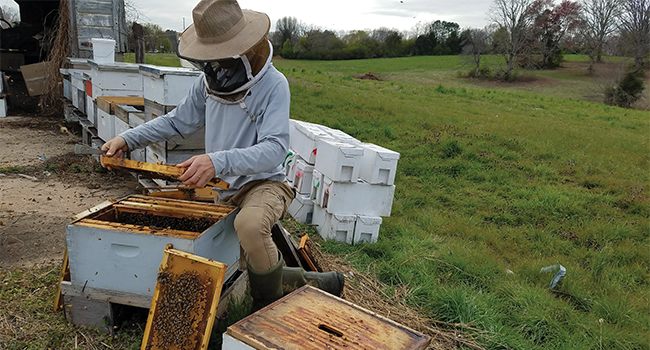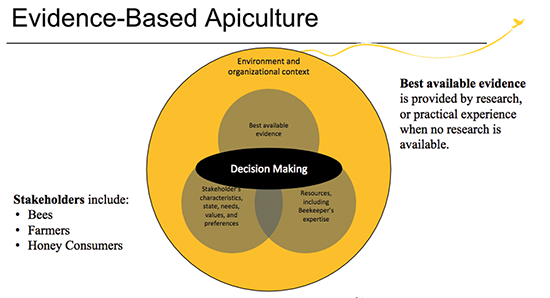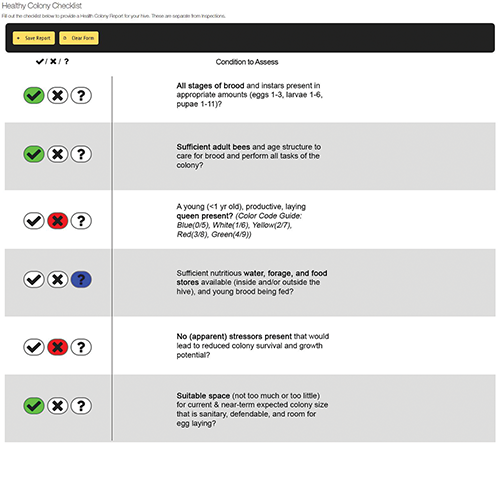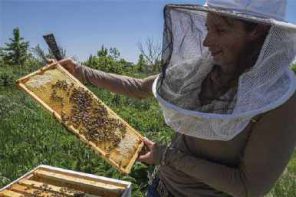By: Joseph Cazier, Dick Rogers, Edgar Hassler, James Wilkes
Validating and Using the HCC for Hive Inspections.
Introduction
Last month (July 2018) we wrote an article in Bee Culture titled “The Healthy Colony Checklist Part I: A Framework for Aggregating Hive Inspection Data”. In this month’s article we review a few key points from that article and continue the thread with a discussion of some of the ways we are testing and validating the framework followed by a discussion of where and how beekeepers can access and use this framework for their hive inspections and conclude with a discussion of how we see it evolving in the future.
Key Point Review
Why We Need a Framework
A framework is a lens to look at a problem in a certain way that can help focus the mind on the most important items.
By thinking through in advance what really matters, followed by testing and validation, we can make sure our inspections are done efficiently, consistently and with the right focus. With improved methods, hive inspections can be done more frequently for the same time investment, giving you a better view of activities in the hive and more consistent and timely data to help find and manage problems sooner, resulting in better hive outcomes.
A key benefit of using a common framework is the ability to pool or aggregate our hive inspection data. If you can learn useful information from inspecting your own hives, imagine what you can learn from everyone’s hive inspections. If everyone used a common hive inspection method and consistently recorded that data in a way that could be shared (even anonymously), we would have “Big Data”. This data could then be analyzed for key principles that work in very different situations to personalize hive management based on a variety of management actions. This Apiary Management System would lead to better beekeeping for all.
For more discussion about why this data collection is so important, please see the article “Peering Into the Future: The Path to the Genius Hive” in the April 2018 issue of Bee Culture.
What the Healthy Colony Checklist Is
Note that the Healthy Colony Checklist is both a framework to think about the key factors that define a healthy hive as well as a practical checklist you can use during your bee inspections. The Healthy Colony Checklist is also an inspection form you can use for measuring the health of your hive. It was developed by Dick Rogers, who has over 45 years of beekeeping experience and is currently the Manager or Bee Healthy and Integrated Apiculture Research. He has long defined a healthy hive as:
A healthy honey bee colony has below threshold levels of parasites, pathogens, and predators; no deficiency of, or out of balance, beneficial microbes; and strength and health is sustainable with a reasonable amount of management by the beekeeper to provide food, shelter, and safety as needed, as for any livestock operation.
This definition has been tested and refined over the years into a practical and useful way to inspect colonies using six key concepts to guide the hive inspections. This system has also been released to the public in an open source format for anyone to use. The key concepts are as follows:
- Brood – All stages of brood and instars present in appropriate amounts
- Adults – Sufficient adult bees and age structure to care for brood and perform all tasks of the colony
- Queen – A young, productive, laying queen present
- Nourishment – Sufficient nutritious water, forage, and food stores available
- Stressors – No apparent stressors present that would lead to reduced colony survival and/or growth potential
- Space – Suitable space for current & near-term expected colony size that is sanitary, defendable, and room for egg laying
By focusing on these few key items, we can quickly assess the health of a hive. If each of these six areas is satisfactory, the hive is generally considered healthy. If one or more areas are struggling you can start a deeper inspection to try to assess likely sub-conditions that are causing the problem and record those as well. In this way, you can do a quick assessment and focus your attention on those hives that need help.
Testing and Validating the Healthy Colony Checklist
Fully testing and validating this framework will take effort from many parties over several years. However, early indications show that this framework is a good starting point. We will summarize the current work being done below.
Beekeeper Survey
With the help of Bee Culture we conducted a survey of beekeepers asking if this framework encapsulates the key information they need to know during hive inspections. Results indicated over 85% support for each of the six key elements of the Healthy Colony Checklist from ~ 700 respondents. Most beekeepers indicated that it was intuitive, easy to use and useful during a hive inspection.
Inspection Form Analysis
In the same survey mentioned above we asked beekeepers to share their inspection forms with us. Most (75%+) indicated they don’t use an inspection form. However, many of those that do use one shared it with us. Additionally, we searched the web for as many forms as we could find from different groups and sent requests to state apiary inspectors across the country for copies of their forms. Many of these were copies of popular forms such as the USDA inspection form; others were unique.
We were able to easily take items from each of the inspection forms and put them into the categories of this framework, listing each item on a form by frequency (percentage) of occurrence to get a sense for what information beekeepers that use inspection forms today are collecting. Figure 2 shows an example of how this was done. Should there be any problems with the brood or other categories, the sub-conditions would help identify the issue and allow you to dig deeper into the problem area. This was done for each of the six macro conditions listed above.

Figure 2. Sample of HIve Inspection Form Analysis for Brood Category Showing Percent of analyzed Forms that EAch LIsted Feature.
Cognitive Feedback
We are currently offering a version of this inspection framework on our website at HiveTracks.com for our users to test and adopt. Over time we will be able to assess the inspection frequency and quality to see if users find it cognitively easier and more effective to use, especially as we compare outcomes over time. We are hoping to see increased inspection frequency, consistency and usefulness as more beekeepers adopt this approach on the HiveTracks.com platform.
Systematic Literature Review
We are also looking into the science surrounding honey bees and beekeeping. We are currently in the process of mapping and reviewing the extensive body of scientific research to see how the framework is supported from a theoretical standpoint. This investigation may yield additional items that should be included in the framework, refinement of existing framework items, and scientifically tested explanations of how the framework components interact.
Where support for a portion of the framework appears to be lacking evidence, we can examine possible reasons for the discrepancy. Is it due to common misconceptions that simply do not stand up to testing? Perhaps researchers have not investigated that area. Figure 3 presents a graphic of this Systematic Literature Review process and how it leads to Evidence Based Apiculture.
Systematic reviews of this type benefit both beekeepers and researchers. For beekeepers, we can extract best practices that are theoretically and empirically supported. For researchers, such studies serve to summarize our knowledge of a topic, highlight areas that remain unresolved, and suggest new directions for research.
Evaluating and implementing the HCC at the Bayer Bee Care Center
At the Bayer Bee Care Center in Research Triangle Park, NC, the Healthy Colony Checklist was implemented as standard procedure along with near-weekly hive inspections in early 2016. The HCC has proven to decrease the time required for thorough colony assessments (HCC <15 min, standard colony condition assessment for research purposes 60-90 min., other methods 30-45 min). The HCC answers the key questions about colony health status, improves identification of corrective actions needed and task scheduling, provides an indispensable aid for training seasonal staff, standardizes the inspection and management of colonies, and provides adequate data for tracking issues and trends.
The goal is to satisfy each condition at least 80% of the time. Our results show that queen issues (failure of queens in their second year) and stressors (mainly Varroa) are the most common problems. Figure 4 presents this data visually.
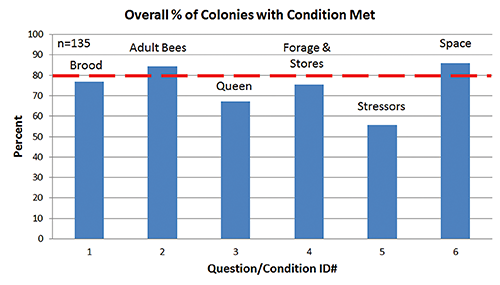
Figure 4. Percentage of times each condition of the HCC was met for all inspections of the Bayer Bee Care Center research apiary hives in 2016. The goal is to achieve healthy conditions at least 80% of the time.
How to Find and Use the HCC
As mentioned last month, any framework that is created and adopted will likely need to evolve over time and adapt to changing circumstances. As we acquire more data, we will be able to test the relative importance of various data elements to see what works well from a management standpoint. We are still in the early stages of testing. We are sure that this framework will continue to evolve, but preliminary tests indicate that it is comprehensive, useful and easy to use. Access to the Healthy Colony Checklist is provided on the Bayer’s Bee Heath website and on HiveTracks.com.
Bayer’s Bee Health website
The latest version of the HCC form can be downloaded from beehealth.bayer.us. The site includes a short article, a news post, and a video about the checklist as well. To request a spreadsheet template for summarizing the HCC forms, and/or to express an interest in accessing the pre-publication version of the airtable HCC database, please contact dick.rogers@bayer.com. Constructive feedback would also be appreciated.
We have built the Healthy Colony Checklist into the HiveTracks.com Hobbyist platform and made it available for use with our system and all of your other bee data at HiveTracks.com. It is an easy to use digital implementation that can be done on the website or a mobile device within our app.
During a hive inspection you can look at the six key factors in the framework and simply mark if they are satisfactory, not satisfactory, or you are unsure. You can also take and upload a picture for future reference and comparisons. In this way, the information is recorded automatically and seamlessly with all of your other data. Figure 5 represents the form on the HiveTracks.com webpage.
The Future of the Healthy Colony Checklist
From our experience of testing and using the Healthy Colony Checklist we anticipate a bright future for it. It has shown itself to be easy to use, focused and useful. Additionally it provides a way to aggregate data across different inspectors, different locations and over time. Even by itself, the HCC is a good tool for people to use in evaluating their own hives. However, when this data is collected electronically and combined with other data, it has the potential to take us one step closer to building the Genius Hive as outlined in our first article in the April issue of Bee Culture. As described below, we are taking several steps to make the HCC more accessible and useful for the average beekeeper.
From Paper to Processor
Moving the Healthy Colony Checklist from paper to an electronic format (see HiveTracks.com for an electronic form) means beekeepers won’t need to carry around a pen to mark their Xs and checkmarks, and they won’t need to transfer data into a summary spreadsheet if they want to do further analyses.
Most importantly, the open source checklist could become a standard for beekeepers around the world. Beekeepers could then discuss the health of their colonies relative to a common set of conditions as opposed to random observations stemming from various levels of knowledge and methods.
Training Program
Some beekeepers may discover that they are uncomfortable with, or don’t know, how to assess some of the conditions on the Checklist. If you don’t know how to assess a condition, you have a knowledge gap which you need to fill. The ability to identify and fill knowledge gaps is another advantage of the Healthy Colony Checklist. Once knowledge gaps are identified, beekeepers can focus self-learning on these areas, or instructors can target the real needs of students.
We hope to develop a training program to help people learn to use and assess their hives with the HCC, perhaps with video and quality checking or mentoring attached. As discussed earlier, the more consistent the inspection, the more valuable the collected data will be.
Sub-Conditions
In addition to the six key conditions of a healthy colony, sub-conditions and fatal conditions for each item have been identified. All these conditions have been used to develop a relational database that will soon be available in AirTable Universe (free airtable.com account required), an online platform where AirTable database templates can be published so anyone, especially beekeepers, can access and use the more comprehensive version of the HCC. In addition, Healthy Colony Checklist implementations and training are in the works for other platforms, such as HiveTracks.com. There is also a Healthy Colony Checklist for bumblebees under development by Dick and his colleagues.
Updates
We plan to update and modify the framework as we learn more from the data. The current framework is a good starting point, but unless we all use it, we won’t know what to update.
We need a common framework to improve our inspections so we can learn more from the universally collected data. Currently few beekeepers pool their data with other beekeepers for analysis or for learning from each other. This framework can help start that process in a systematic way. Please consider adopting it for your operation, not just for yourself, but for all the other beekeepers that could benefit from your wisdom and experience.
Finally, special thanks to Project Apis m. for supporting a portion of this work with a Healthy Hives 2020 grant and to Bee Culture for providing a venue for sharing these ideas with an interested audience.
Joseph Cazier is the Chief Analytics Officer for HiveTracks and the Director of the Center for Analytics Research and Education at Appalachian State University. He spends his days thinking about ways to use analytics for good and then finding ways to do them. You can reach him at joseph@hivetracks.com.
Richard (Dick) Rogers is the manager of bee health research at the Bayer Bee Care Center.
Ed Hassler is an Assistant Professor in Information Systems and Associate Director of CARE for Technology at Appalachian State University.
James Wilkes is the Founder and CEO of Hivetracks. and a Computer Science Professor at Appalachian State University. His lifelong passion for bees keeps fueling the development and mission of HiveTracks software. You can reach him at james@hivetracks.com.







